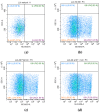Tumor-Suppressive Cross-Linking of Anti- T. cruzi Antibodies in Acute Lymphoblastic Leukemia
- PMID: 39125875
- PMCID: PMC11313589
- DOI: 10.3390/ijms25158307
Tumor-Suppressive Cross-Linking of Anti- T. cruzi Antibodies in Acute Lymphoblastic Leukemia
Abstract
Parasites have been associated with possible anticancer activity, including Trypanosoma cruzi, which has been linked to inhibiting the growth of solid tumors. To better understand this antitumor effect, we investigated the association of anti-T. cruzi antibodies with B cells of the acute lymphoblastic leukemia (ALL) SUPB15 cell line. The antibodies were generated in rabbits. IgGs were purified by affinity chromatography. Two procedures (flow cytometry (CF) and Western blot(WB)) were employed to recognize anti-T. cruzi antibodies on SUPB15 cells. We also used CF to determine whether the anti-T. cruzi antibodies could suppress SUPB15 cells. The anti-T. cruzi antibodies recognized 35.5% of the surface antigens of SUPB15. The complement-dependent cytotoxicity (CDC) results demonstrate the cross-suppression of anti-T. cruzi antibodies on up to 8.4% of SUPB15 cells. For the WB analysis, a band at 100 kDa with high intensity was sequenced using mass spectrometry, identifying the protein as nucleolin. This protein may play a role in the antitumor effect on T. cruzi. The anti-T. cruzi antibodies represent promising polyclonal antibodies that have the effect of tumor-suppressive cross-linking on cancer cells, which should be further investigated.
Keywords: Trypanosoma cruzi; acute lymphoblastic leukemia; anti-T. cruzi antibodies; tumor-suppressive cross-linking.
Conflict of interest statement
The authors declare no conflicts of interest. The funders had no role in the design of the study; in the collection, analyses, or interpretation of data; in the writing of the manuscript; or in the decision to publish the results.
Figures







Similar articles
-
Trypanosoma cruzi: detection of a surface antigen cross-reactive to human C-reactive protein.Exp Parasitol. 1998 Oct;90(2):143-53. doi: 10.1006/expr.1998.4323. Exp Parasitol. 1998. PMID: 9769244
-
Altering the motility of Trypanosoma cruzi with rabbit polyclonal anti-peptide antibodies reduces infection to susceptible mammalian cells.Exp Parasitol. 2015 Mar;150:36-43. doi: 10.1016/j.exppara.2015.01.007. Epub 2015 Jan 26. Exp Parasitol. 2015. PMID: 25633439
-
Trypanosoma cruzi extracts elicit protective immune response against chemically induced colon and mammary cancers.Int J Cancer. 2016 Apr 1;138(7):1719-31. doi: 10.1002/ijc.29910. Epub 2015 Nov 20. Int J Cancer. 2016. PMID: 26519949
-
Trypanosoma cruzi Antigenic Proteins Shared with Acute Lymphoblastic Leukemia and Neuroblastoma.Pharmaceuticals (Basel). 2022 Nov 17;15(11):1421. doi: 10.3390/ph15111421. Pharmaceuticals (Basel). 2022. PMID: 36422551 Free PMC article.
-
Anti-alpha-galactosyl antibodies in chagasic patients. Possible biological significance.Braz J Med Biol Res. 1988;21(6):1275-86. Braz J Med Biol Res. 1988. PMID: 2471563 Review.
Cited by
-
Association of Neuroblastoma (NB) SH-SY5Y Cells with Antibodies of Parasitic Origin (Anti-Acanthamoeba and Anti-Toxocara canis).Int J Mol Sci. 2024 Dec 19;25(24):13577. doi: 10.3390/ijms252413577. Int J Mol Sci. 2024. PMID: 39769340 Free PMC article.
-
Molecular mimicry between parasites and cancer: a novel approach for developing cancer vaccines and therapeutic antibodies.Cancer Immunol Immunother. 2025 May 22;74(7):212. doi: 10.1007/s00262-025-04069-1. Cancer Immunol Immunother. 2025. PMID: 40402283 Free PMC article.
-
Bridging the gap for diverse applications of parasites as advanced cancer therapeutics: current progress and future directions.Infect Agent Cancer. 2025 Jul 29;20(1):53. doi: 10.1186/s13027-025-00679-7. Infect Agent Cancer. 2025. PMID: 40731364 Free PMC article. Review.
References
-
- Jimenez-Hernandez E., Jaimes-Reyes E.Z., Arellano-Galindo J., Garcia-Jimenez X., Tiznado-Garcia H.M., Dueñas-Gonzalez M.T., Villegas O.M., Sánchez-Jara B., Bekker-Méndez V.C., Ortíz-Torres M.G., et al. Survival of Mexican Children with Acute Lymphoblastic Leukemia under Treatment with the Protocol from the Dana-Farber Cancer Institute 00-01. BioMed Res. Int. 2015;2015:576950. doi: 10.1155/2015/576950. - DOI - PMC - PubMed
-
- Flores-Lujano J., Duarte-Rodríguez D.A., Jiménez-Hernández E., Martín-Trejo J.A., Allende-López A., Peñaloza-González J.G., Pérez-Saldivar M.L., Medina-Sanson A., Torres-Nava J.R., Solís-Labastida K.A., et al. Persistently high incidence rates of childhood acute leukemias from 2010 to 2017 in Mexico City: A population study from the MIGICCL. Front. Public Health. 2022;10:918921. doi: 10.3389/fpubh.2022.918921. - DOI - PMC - PubMed
MeSH terms
Substances
Grants and funding
LinkOut - more resources
Full Text Sources
Research Materials

